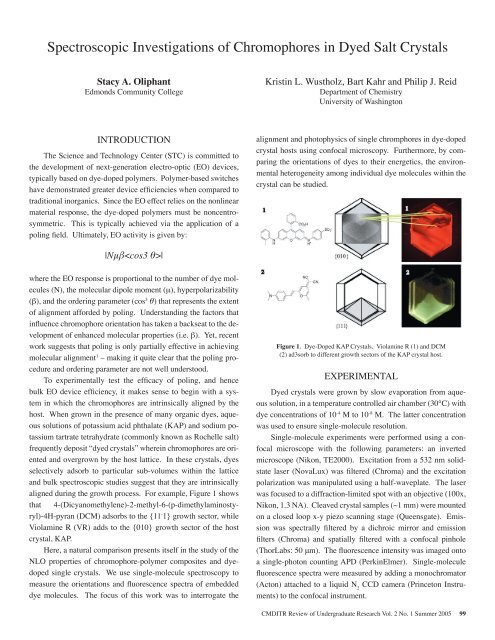Student Project Abstracts 2005 - Pluto - University of Washington
Student Project Abstracts 2005 - Pluto - University of Washington
Student Project Abstracts 2005 - Pluto - University of Washington
You also want an ePaper? Increase the reach of your titles
YUMPU automatically turns print PDFs into web optimized ePapers that Google loves.
Spectroscopic Investigations <strong>of</strong> Chromophores in Dyed Salt CrystalsStacy A. OliphantEdmonds Community CollegeKristin L. Wustholz, Bart Kahr and Philip J. ReidDepartment <strong>of</strong> Chemistry<strong>University</strong> <strong>of</strong> <strong>Washington</strong>INTRODUCTIONThe Science and Technology Center (STC) is committed tothe development <strong>of</strong> next-generation electro-optic (EO) devices,typically based on dye-doped polymers. Polymer-based switcheshave demonstrated greater device efficiencies when compared totraditional inorganics. Since the EO effect relies on the nonlinearmaterial response, the dye-doped polymers must be noncentrosymmetric.This is typically achieved via the application <strong>of</strong> apoling field. Ultimately, EO activity is given by:alignment and photophysics <strong>of</strong> single chromphores in dye-dopedcrystal hosts using confocal microscopy. Furthermore, by comparingthe orientations <strong>of</strong> dyes to their energetics, the environmentalheterogeneity among individual dye molecules within thecrystal can be studied.|Nµβ|where the EO response is proportional to the number <strong>of</strong> dye molecules(N), the molecular dipole moment (μ), hyperpolarizability(β), and the ordering parameter (cos 3 θ) that represents the extent<strong>of</strong> alignment afforded by poling. Understanding the factors thatinfluence chromophore orientation has taken a backseat to the development<strong>of</strong> enhanced molecular properties (i.e. β). Yet, recentwork suggests that poling is only partially effective in achievingmolecular alignment 1 – making it quite clear that the poling procedureand ordering parameter are not well understood.To experimentally test the efficacy <strong>of</strong> poling, and hencebulk EO device efficiency, it makes sense to begin with a systemin which the chromophores are intrinsically aligned by thehost. When grown in the presence <strong>of</strong> many organic dyes, aqueoussolutions <strong>of</strong> potassium acid phthalate (KAP) and sodium potassiumtartrate tetrahydrate (commonly known as Rochelle salt)frequently deposit “dyed crystals” wherein chromophores are orientedand overgrown by the host lattice. In these crystals, dyesselectively adsorb to particular sub-volumes within the latticeand bulk spectroscopic studies suggest that they are intrinsicallyaligned during the growth process. For example, Figure 1 showsthat 4-(Dicyanomethylene)-2-methyl-6-(p-dimethylaminostyryl)-4H-pyran(DCM) adsorbs to the {11 - 1} growth sector, whileViolamine R (VR) adds to the {010} growth sector <strong>of</strong> the hostcrystal, KAP.Here, a natural comparison presents itself in the study <strong>of</strong> theNLO properties <strong>of</strong> chromophore-polymer composites and dyedopedsingle crystals. We use single-molecule spectroscopy tomeasure the orientations and fluorescence spectra <strong>of</strong> embeddeddye molecules. The focus <strong>of</strong> this work was to interrogate theFigure 1. Dye-Doped KAP Crystals. Violamine R (1) and DCM(2) ad3sorb to different growth sectors <strong>of</strong> the KAP crystal host.EXPERIMENTALDyed crystals were grown by slow evaporation from aqueoussolution, in a temperature controlled air chamber (30°C) withdye concentrations <strong>of</strong> 10 -4 M to 10 -8 M. The latter concentrationwas used to ensure single-molecule resolution.Single-molecule experiments were performed using a confocalmicroscope with the following parameters: an invertedmicroscope (Nikon, TE2000). Excitation from a 532 nm solidstatelaser (NovaLux) was filtered (Chroma) and the excitationpolarization was manipulated using a half-waveplate. The laserwas focused to a diffraction-limited spot with an objective (100x,Nikon, 1.3 NA). Cleaved crystal samples (~1 mm) were mountedon a closed loop x-y piezo scanning stage (Queensgate). Emissionwas spectrally filtered by a dichroic mirror and emissionfilters (Chroma) and spatially filtered with a confocal pinhole(ThorLabs: 50 μm). The fluorescence intensity was imaged ontoa single-photon counting APD (PerkinElmer). Single-moleculefluorescence spectra were measured by adding a monochromator(Acton) attached to a liquid N 2CCD camera (Princeton Instruments)to the confocal instrument.CMDITR Review <strong>of</strong> Undergraduate Research Vol. 2 No. 1 Summer <strong>2005</strong> 99




